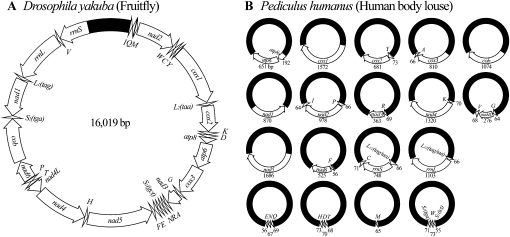Figure 1.
(A) The typical mitochondrial (mt) genome of animals, represented here by a fruitfly, Drosophila yakuba; (B) the mt genome of the human body louse, Pediculus humanus. The mt genome of Drosophila yakuba consists of a single circular chromosome that is 16,019-bp long and has 37 genes (GenBank accession no. NC_001322). The mt genome of P. humanus, however, consists of 18 minicircular chromosomes; each minicircular chromosome is 3000–4000-bp long and has one to three genes. Genes are represented as boxes and are drawn to scale. The length of each gene of P. humanus is indicated near the box that represents the gene. Arrows indicate the direction of transcription. Protein-coding genes are abbreviated as atp6 and atp8 (for ATP synthase subunits 6 and 8), cox1-3 (for cytochrome c oxidase subunits 1 to 3), cob (for cytochrome b), and nad1-6 and 4L (for NADH dehydrogenase subunits 1–6 and 4L). rrnL and rrnS are for large and small rRNA subunits. tRNA genes are shown with the single-letter abbreviations of their corresponding amino acids. The noncoding regions are in black. The 18 minichromosomes of P. humanus are in alphabetical order according to the names of their protein-coding and rRNA genes; those with only tRNA genes are in the last row.

